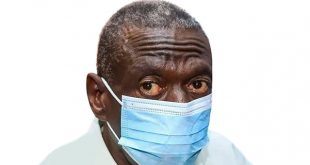
By Mubatsi Asinja Habati
Now health experts debate wisdom of switching chemical sprays
Lying on flat land near the swampy Lake Kyoga, Apac district in northern Uganda, Lango sub-region, is not only the most malaria infected region of Uganda, but perhaps of the entire world. A study conducted from 1994 to 2005 among some districts in Uganda revealed that Apac had the highest number of infective mosquito bites 1,564 a year compared to less than one infective bite in Kabale region. In Uganda, approximately 320 children and women die of malaria and records from the ministry of health show that malaria accounts for 25-40 percent of outpatient visits to health facilities and is responsible for nearly half of inpatient child deaths.
A Member of Parliament from Apac described the malaria burden in his area as a big disaster that has not received the necessary government attention. Considering the malaria-related deaths, it is more than any other epidemic that has hit Apac. Every family has been affected, Maruzi County MP David Ebong told The Independent. We are still in the prison of malaria. We have many cases where people die when they cannot access treatment. Most of them are poor. The government health facilities where they can get drugs free of charge have consistent stock shortages. People continue to die every day, even when the disease is preventable.

Michael Okia, the senior entomologist at Uganda’s Ministry of Health, offers numerous technical explanations why Apac district bears such a disproportionate malaria burden. Firstly, he says, the presence of large bodies of stagnant water breeds mosquitoes. Secondly, being situated on a flat plain, opposed to a hilly terrain, can also be a contributing factor. Finally, Apacs hot temperatures allow malaria-infected mosquitoes to reproduce quicker. Malaria parasites take 56 days to mature in a habitat of 18°c but they take 19 days to mature in a habitat of 22°c and only 8 days in a habitat of 30°c.
Okia says a second type of mosquito called anopheles funestus is also common around the Apac swamps and bushes. These insects, he says, prefer feeding on human blood than animal. Even if a cow is grazing at the swamp, anopheles funestus will go for the cows herdsmans blood.
Since June 2005 when Uganda was considered for the Presidents Malaria Initiative, millions of dollars have been spent fighting the disease. Uganda completed Phase I of a US$66 million Global Fund Round Four grant that provided nationwide supplies of Artemisinin-based Combination Therapies (ACT), a mix of malaria drugs. The Global Fund Round Four Phase II grant ($71 million, signed in 2008) will provide adequate supplies of ACTs nationwide through 2011, and the Round Seven Phase I grant ($51 million, also signed in 2008) will provide 17.7 million long-lasting Insecticide Treated Nets (ITN) to protect the most vulnerable populations. In spite of this Uganda still falls behind regional countries on the target to cut malaria infections by 50 percent by the year 2015 according a recent report on malaria war.Â

In 2006, the government endorsed the use of indoor residual spraying (IRS) as a pilot programme in ten districts, including Apac. IRS was last used in 1963, and has so far made use of three chemicals (DDT, Icon, and Fendona). A fourth, Bendiocrab, a chemical endorsed by the World Health Organisation, will soon be rolled out after health assistants are properly trained on how to use it.
Okia says the use of different chemicals in spraying mosquitoes follows an insecticide management recess in which the health officials tried to foil the mosquitoes from developing resistance to the chemicals used in indoor residual spraying.
“Like malaria parasites in the human body developed resistance to drugs such as chloroquine, mosquitoes can get used to similar insecticides sprayed on them and develop resistance, explains Okia. The use of different chemicals in the indoor residual spray is intended to prevent insects from getting used to one chemical which in turn lead to resistance rendering the chemical not more effective, said Okia.
But Dr Chris Baryomunsi, Deputy Chairperson on Parliaments Social Services Committee, says although it sounds reasonable for mosquitoes to build up a resistance to chemicals, continual use is actually effective. Continually using the same chemical in spraying is better. Resistance comes in when you interrupt the flow of spraying.
Baryomunsi adds that a chemical like Icon is more expensive but relatively safer because it is less associated with environmental controversy and spraying it has significantly worked in my area (Kinkizi, Western Uganda) as the outpatient malaria cases have gone down.
The spraying of DDT has also been effective in eradicating malaria in a number of countries. DDT was for instance, used in Europe, and several countries in Asia in quarter of the 20th century, where malaria is now history.
IRS (using DDT) was first used in Uganda between 1959 and 1963 in Kigezi during the malaria pilot eradication project and the results were promising as the disease was almost eliminated and mosquitoes were greatly eliminated.
In fact, the first chemical to use in the IRS project in July 2006 was DDT and clinical records of inpatient cases from the medical ward at Kabale regional Hospital indicate that the malaria cases dropped from 90 in July to 40 in August. Cases then fell to 30 in September and 25 in October but increased in November to 42.
According to records from the ministry of health, different chemicals used in IRS have different durations of effectiveness. DDT has more than six months, which is the longest, per dosage. The effectiveness of Icon lasts between three and six months after spraying while Bendiocarb is suppose to be effective from two to six months.
Ebong says government has to take an integrated approach in the fight against malaria. He notes that concurrent emphasis on the use of treated bed nets, indoor residual spraying with DDT, massive sensitisation of prevention of malaria and by-laws to make people heed the preventive measures should take centre stage. He wonders why the distribution of bed nets began in central and western Uganda instead of Apac where the disease is highly endemic. If government can eradicate malaria in Apac as a pilot scheme, it can deal with malaria in the country, said Ebong.
In Apac each person is still bitten on average five times a day by an infective mosquito and Ebong says the IRS has not worked. Its only DDT which appeared to have worked, he says and urges the government to avoid switching back to other chemicals.
So far through IRS, over 800,000 houses have been sprayed and nearly three million people protected from malaria in eight districts, including Apac. According to the Malaria Operation Plan 2010, some 700,000 houses will be sprayed in the six districts leaving more than 2.6 million people protected. Yet there are still many people who refuse to have their homes sprayed out of fear of health and environment consequences. Other challenges include mosquitoes resurfacing from unsprayed area to attack people in areas that have been sprayed.
 The Independent Uganda: You get the Truth we Pay the Price
The Independent Uganda: You get the Truth we Pay the Price


